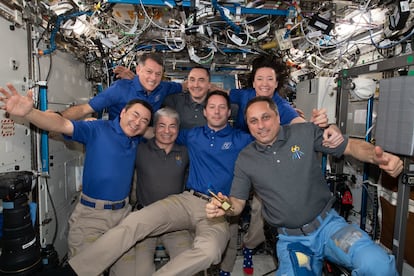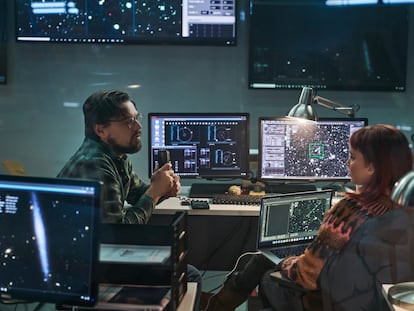How the crew of the International Space Station could become unlikely collateral victims of the conflict in Ukraine
The director of the Russian space agency has warned that sanctions could have an effect on the long-running mission

Right now, on board the International Space Station (ISS), there are four American astronauts, two Russians and one German. They are living 400 kilometers above the Earth, but could become the most unexpected collateral victims of the war in Ukraine.
“If the US blocks cooperation with us, who will save the ISS from an uncontrolled exit of its orbit or from crashing onto the US or Europe?” asked Dimitri Rogozin, director of Roscosmos, the Russian space agency.
The United States and Russia have been cooperating for nearly 25 years on this advanced space station, along with European, Canadian and Japanese input. Yesterday, US President Joe Biden announced a new series of sanctions against Russia, which, among other things, target their “aerospace industry, including the space program.”
The Russian response, from the head of Roscosmos – a journalist, philosopher, expert in war theory, former ambassador to NATO and ex-vicepresident of the country – was incendiary. “There is also the option that a 500-ton structure could fall on India and China. Does [Biden] want to threaten them with that scenario?” he wrote on Twitter.
САНКЦИИ АЛЬЦ-ГЕЙМЕРА
— РОГОЗИН (@Rogozin) February 24, 2022
Байден заявил, что новые санкции коснутся российской космической программы. Ок. Остается выяснить детали:
1. Вы хотите перекрыть нам доступ к радиационностойкой микроэлектронике космического назначения? Так вы это уже сделали вполне официально в 2014 году.
The tensions between Russia, the US and the EU could have significant consequences for space exploration. In 2014, after the Russian invasion of the Crimean peninsula, NASA sent a directive to its employees to suspend contact with Russian counterparts. The agency banned travel to Russia for all of its employees. Rogozin was punished with a ban on entry to the US – the EU did the same, and paralyzed all its accounts in the bloc’s member states.
After Rogozin’s statements, NASA has stated that cooperation with Russia on the ISS will remain intact. Despite the new economic sanctions, “civil cooperation in space between Russia and the US will continue,” a NASA spokesperson told CNN. The agency “continues to work with its international partners, including Roscosmos, on the operation of the ISS,” it added.
Until now, the US and Russia had left the space station outside of political combat and economic sanctions. The clearest precedent was the Russian invasion of Crimea in 2014. Despite the US sanctions, the ISS continued to operate with normality. The US astronauts continued to fly on Russian Soyuz craft and the ISS operations were not affected.
In November 2021, Russia blew up one if its satellites by firing a missile at it. The remains of the object, which are as dangerous as shrapnel, seriously threatened the ISS crew. The US made an official complaint to Russia about this maneuver, but relations did not break down.
But the ISS has an uncertain future. Last year, Russia warned that if the US did not lift its sanctions – in particular on electronic components for spaceships and satellites that are hindering the progress of Russian missions – its commitment for collaboration with ISS will not be renewed in 2025. The US wants to continue with the project until at least 2030 and likely beyond that date.
Space X
The war in Ukraine could have serious effects on the US, Russian and European space programs. Until a few years ago, the US could only send astronauts to space on board Russian Soyuz spacecraft. But since 2020, the country has had an alternative: the private Space X ships, from the company owned by billionaire entrepreneur Elon Musk. That said, the US is still sporadically using Russian craft. Francisco Rubio, a US helicopter pilot and astronaut, is planning to arrive on the ISS on board a Soyuz. Russia is also planning to use the private Space X to send cosmonauts to the space station, according to The Verge.
Europe also depends on Russian technology in space. The European Space Agency regularly uses Soyuz rockets to send unmanned missions to space, as was the case with the Cheops space telescope in 2019. In April, there are plans for a Soyuz to send two Galileo satellites into orbit – the navigation system developed by the European Union. The ESA and Roscosmos are also working on Exomars, a robotic exploration mission on Mars. The program has cost $1.46 billion (€1.3 billion), and the plan is to send the robot to look for life on the red planet between August and October 2022.
Tu suscripción se está usando en otro dispositivo
¿Quieres añadir otro usuario a tu suscripción?
Si continúas leyendo en este dispositivo, no se podrá leer en el otro.
FlechaTu suscripción se está usando en otro dispositivo y solo puedes acceder a EL PAÍS desde un dispositivo a la vez.
Si quieres compartir tu cuenta, cambia tu suscripción a la modalidad Premium, así podrás añadir otro usuario. Cada uno accederá con su propia cuenta de email, lo que os permitirá personalizar vuestra experiencia en EL PAÍS.
¿Tienes una suscripción de empresa? Accede aquí para contratar más cuentas.
En el caso de no saber quién está usando tu cuenta, te recomendamos cambiar tu contraseña aquí.
Si decides continuar compartiendo tu cuenta, este mensaje se mostrará en tu dispositivo y en el de la otra persona que está usando tu cuenta de forma indefinida, afectando a tu experiencia de lectura. Puedes consultar aquí los términos y condiciones de la suscripción digital.
More information
Últimas noticias
Most viewed
- Sinaloa Cartel war is taking its toll on Los Chapitos
- Oona Chaplin: ‘I told James Cameron that I was living in a treehouse and starting a permaculture project with a friend’
- Reinhard Genzel, Nobel laureate in physics: ‘One-minute videos will never give you the truth’
- Why the price of coffee has skyrocketed: from Brazilian plantations to specialty coffee houses
- Silver prices are going crazy: This is what’s fueling the rally











































